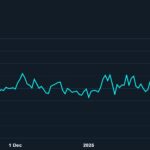March proved to be a tumultuous month for the cryptocurrency markets, shaped largely by uncertainty stemming from US President Donald Trump’s evolving tariff policies. As the trade tensions escalated, particularly with China and the European Union, Bitcoin and other cryptocurrencies experienced significant volatility. On March 10 and 12, retaliatory tariffs against US goods ignited market shifts, causing Bitcoin’s price to fluctuate dramatically—initially rising to ,000 on March 24 before retracting to around ,000 as the month drew to a close.
Amid these pressures, interest in decentralized finance, or DeFi, waned as security concerns came to the forefront. March was not without legislative developments; a growing number of US states advanced Bitcoin-related bills, signaling a push towards clearer regulation and the establishment of frameworks for cryptocurrency and blockchain technology. Notably, Utah and Kentucky enacted laws that provide essential definitions and protections for crypto miners and businesses, while other states like Texas, Georgia, and Illinois introduced various new legislative proposals.
Meanwhile, the Solana ecosystem faced a staggering decline in revenue, primarily due to a cooling off in the memecoin market. Following peaks in late January, decentralized exchange volumes plummeted, revealing a stark drop in trading activity. Analysts speculated on the implications for future revenue, though some experts maintained a hopeful outlook for the blockchain’s underlying technology.
“One of the cool things about the memecoin speculation is it drove a huge investment in infrastructure on Solana,” said Kain Warwick, a noteworthy voice in the industry.
On another front, DeFi was further rattled by a spate of hacks, totaling million in losses. Analysts raised red flags about the security of decentralized protocols, with some experts suggesting that unless the industry takes accountability, it may face regulation that could stifle innovation. Despite the challenges, the crypto community continued to gather at international conferences, highlighting a commitment to building and evolving the sector.
As March closed with many major coins declining—Ether down 18%—the stage is set for April, which promises to bring more regulatory discussion and potential market shifts, particularly with the looming introduction of mass tariffs by Trump on April 2, dubbed “Liberation Day.”
March Market Volatility and Legislative Developments
March proved to be a tumultuous month for financial markets, particularly within the cryptocurrency space. Below are the key points that highlight the significant impacts:
- Market Volatility Due to Tariff Policies:
- Trump’s uncertain tariff policies caused significant volatility in Bitcoin and crypto markets.
- Bitcoin briefly recovered to ,000 on March 24, only to slump again to around ,000.
- Overall, Bitcoin was down 5% for the month due to the impacts of the trade war.
- Legislative Momentum for Cryptocurrency:
- Legislatures in 13 US states explored crypto legislation, covering aspects like Bitcoin reserves and crypto tax forces.
- Utah and Kentucky enacted laws defining digital assets and providing regulations for crypto businesses.
- Texas introduced three significant bills aimed at creating oil-backed stablecoins and investing state funds in crypto.
- Solana’s Revenue Decline:
- Solana recorded a drastic 99% decrease in revenues, dropping from billion to around billion in trading volumes.
- The decline is attributed to a cooling memecoin market and notable investor exit from Solana’s ecosystem.
- Analysts express concern that this downturn could lead to broader revenue declines across the DeFi landscape.
- Security Risks in DeFi:
- March saw million stolen from various DeFi hacks, raising security concerns among investors.
- The increasing frequency of hacks highlights the need for stronger regulations and accountability within the industry.
- Community discourse suggests that without regulations, the situation may continue to deteriorate.
Concerns over security and macroeconomic factors could significantly affect individual investments in crypto assets and their perceived value.
These developments are crucial for readers considering investments in cryptocurrency. The legislative efforts may pave the way for increased legitimacy and security in the market, while ongoing volatility and security risks highlight the challenges investors face. Understanding these factors is vital for making informed decisions in an ever-evolving landscape.
Market Turbulence: Analyzing Crypto’s Reaction to Political Uncertainty
The tumultuous month of March left no stone unturned in the crypto markets, showcasing how intertwined digital currencies are with global political dynamics. President Donald Trump’s shifting tariff policies caused significant volatility, particularly affecting Bitcoin, which experienced a fluctuating trajectory, momentarily rallying to ,000 before dropping back to around ,000. This serves as a reminder of how sensitive cryptocurrencies are to external factors, especially political maneuvers and trade wars. In contrast to Bitcoin, other cryptocurrencies within the decentralized finance (DeFi) space struggled due to rising security concerns, resulting in a clouded outlook for new investors.
Competitive Advantages: With traditional finance showing signs of strain under political pressures, Bitcoin’s perceived robustness might lure cautious investors seeking an alternative store of value. Moreover, the proactive legislative efforts in states like Utah and Kentucky signal a growing legitimization and maturity in crypto as it garners official recognition. This can build a more stable ecosystem for Bitcoin and other digital assets, potentially leading to increased autonomy in decision-making free from major global economic disturbances.
Competitive Disadvantages: The ramifications of Trump’s trade policies are far-reaching, exemplified by Bitcoin’s decline of 5% within the month. This distinct volatility makes it hard for new investors to gauge risk and return accurately, thereby complicating investment strategies. Additionally, Solana’s related troubles stem from plummeting revenues that dropped by 99%, primarily due to scandals and a downturn in the memecoin market. This raises questions about the sustainability of platforms heavily reliant on volatile assets, suggesting that they could face prolonged challenges unless they diversify effectively.
As we navigate the implications of these market conditions, investors looking for stability may find solace in structured investments backed by the growing regulatory frameworks emerging in several U.S. states. On the flip side, less experienced traders may encounter significant challenges as they attempt to decipher the complex interdependencies between market movements and political events. Additionally, long-standing platforms like Solana will need to pivot swiftly to recapture investor interest, lest they fall further behind amid an increasingly competitive landscape.
Moreover, with security breaches on the rise and analysts sounding alarms over vulnerabilities in DeFi protocols, wary investors might find themselves reconsidering their stake in these risky assets. The call for tighter regulations could create a double-edged sword—potentially curbing innovative growth while offering a safer environment for future investments. Those who hope to optimize their portfolios will need to adapt quickly to the rapidly changing risk dynamic in this space.

















